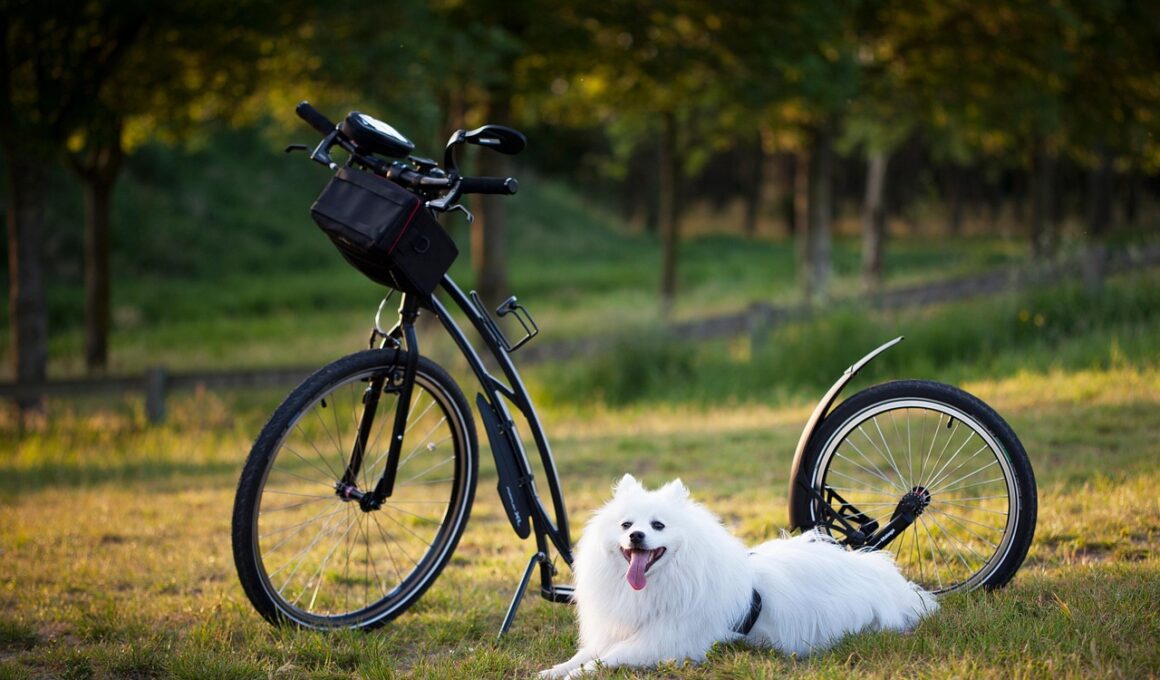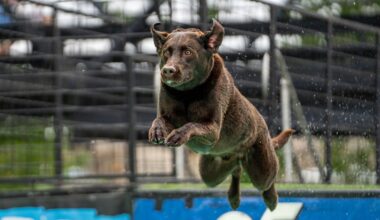The Science Behind Exercise and Fat Metabolism in Dogs
Exercise plays a crucial role in maintaining the health of dogs, particularly in preventing obesity, which can be a significant issue among canines. With the rise in pet ownership, especially in urban environments, dogs often struggle to get enough physical activity. Obesity in dogs can lead to various health problems, including heart disease, diabetes, and joint issues. Understanding how exercise affects fat metabolism can help owners create effective exercise routines tailored for their pets. Regular exercise increases energy expenditure, which is essential for weight control. Dogs, much like humans, burn calories during physical activity, leading to a reduction in stored fat when combined with proper nutrition. Exercise also improves metabolic rates and overall health, thereby increasing stamina and vitality. Dogs who engage in regular physical activity often experience enhanced moods, reduced anxiety levels, and increased sociability. This leads to a better quality of life for dogs and strengthens the bond between pets and their owners. Ensuring a balanced approach to diet and exercise is crucial in managing canine obesity and promoting longevity in dogs.
Understanding Canine Obesity
Canine obesity is a growing concern among pet owners and veterinary professionals, as it can significantly affect a dog’s health. To effectively tackle obesity, it is important to understand its causes, risks, and how exercise can play a pivotal role in management. Obesity occurs when a dog consumes more calories than it expends through everyday activities. Factors contributing to this issue include overfeeding, lack of exercise, and an inactive lifestyle. Additionally, age and breed predisposition can make certain dogs more prone to gaining excess weight. Obesity increases the risk of serious health issues such as arthritis, respiratory problems, and even cancer. It is essential for owners to monitor their dogs’ weight and body condition regularly, assessing whether they are within a healthy range. Regular physical activity is vital to combat obesity. Studies show that dogs that exercise consistently maintain a healthier weight and lower fat percentages. This highlights the significance of a well-structured exercise program, tailored to the individual dog’s needs, combined with a nutritious diet to ensure optimal health. Transparent communication with vets can help owners determine appropriate exercise levels and dietary changes.
Incorporating different forms of exercise can enhance a dog’s overall well-being and bolster fat metabolism. Various activities can cater to a dog’s interests and energy levels, making exercise enjoyable rather than a chore. Some effective exercise options include walking, running, playing fetch, or engaging in agility training. Swimming is another fantastic low-impact option, especially for older dogs or those with joint issues. Owners should aim for a minimum of thirty minutes of moderate exercise daily as a foundational guideline to keep their dogs active. Mixing various activities prevents boredom and promotes excitement; using toys and treats can effectively motivate dogs to stay active. It is important to consider each dog’s individual preferences and physical capabilities when designing an exercise routine. Regularly altering the exercise regimen can keep dogs engaged while promoting their physical health. Additionally, utilizing dog parks or playdates with other pets can introduce social elements to fitness routines, ultimately fostering better socialization. Understanding your dog’s personality can increase compliance in exercise routines, making it more effective in preventing obesity and enhancing overall health.
Nutrition and Its Role
Nutrition and exercise go hand-in-hand when addressing canine obesity, as the right dietary choices complement physical activity. Providing dogs with well-balanced meals ensures they receive essential nutrients without excessive calorie intake. Choosing high-quality dog food tailored to their specific age, weight, and activity level is a fundamental step in managing obesity. Owners should consult with a veterinarian to select the most suitable dietary options for their pet. Portion control is equally vital; measuring food and preventing overindulgence help maintain healthy weight. Treats, while occasionally rewarding, should be carefully considered, ensuring they fit within the dog’s daily caloric requirements. Incorporating fruits and vegetables as alternatives to high-calorie treats can be a great way to keep dogs satisfied without compromising their health. Adopting a holistic perspective that combines nutrition and physical activity will maximize results in managing a dog’s weight. Additionally, it is crucial to stay consistent in both diet and exercise for optimal long-term outcomes. Regular check-ins with the veterinarian can help monitor progress and adjust plans as necessary, ensuring that health goals are being met and maintained effectively.
It is essential to recognize the impact mental stimulation has on canine obesity as well. Dogs need mental exercise in addition to physical activity to lead fulfilling lives, which can also affect their weight. Mental stimulation through training, puzzle toys, or interactive games can reduce boredom, which in turn can help prevent overeating due to lack of engagement. Engaging dogs in obedience training not only builds discipline but also provides mental workouts that can tire them out as efficiently as physical exercise. As an added bonus, mental challenges strengthen the dog-owner bond, creating a more cohesive relationship. Incorporating brain games into regular exercise routines broadens the focus from solely physical activities and promotes overall wellness. Strategies such as hiding treats around the home or using toys to encourage problem-solving can provide excellent mental workouts. By including training sessions or playful challenges, owners can enhance their dogs’ mental and physical fitness simultaneously. The result is a well-rounded approach to managing obesity, leading to healthier, happier dogs. Ensuring both aspects are integrated into daily routines will contribute to effective long-term solutions.
Setting Realistic Goals
Effective weight management requires patience and realistic goal-setting for dogs. Owners should understand that gradual weight loss will be more sustainable than quick fixes. Establishing short-term and long-term objectives can help track progress and maintain motivation. A realistic goal might involve aiming for a 1-2% weight loss per week, allowing a safe and steady transition to a healthier body weight. Documenting the dog’s weight regularly and adjusting plans based on progress is crucial. Tracking can include recording daily food intake, noting exercise times, and any behavioral changes. Visible results, whether through weight loss or increased stamina during activities, can encourage persistence in the journey toward better health. Including rewards for meeting milestones—like extra playtime or new toys—can motivate both owners and dogs alike. It reinforces positive associations with exercise and healthy eating. Flexibility also plays a significant role in maintaining motivation; adjusting goals based on the dog’s progress will help avoid frustration for both the pet and owner. Ensuring changes are sustainable in the long run promotes proper lifestyle habits that contribute positively to dogs’ lives.
In conclusion, exercising dogs is essential in preventing obesity and promoting overall well-being. The science of fat metabolism shows that regular physical activity positively impacts weight management, health metrics, and emotional states. Owners must pay attention to both nutrition and exercise, creating tailored plans that suit each individual dog’s needs. By recognizing the signs of canine obesity early, owners can implement strategies that lead to successful weight management. Incorporating a blend of physical and mental exercises fosters fitness, while establishing realistic goals aids in tracking progress. Consulting with veterinarians allows pet owners to receive personalized guidance and ongoing evaluation, ensuring dogs maintain a healthy weight over time. Ultimately, a holistic approach to a dog’s fitness that combines diet, exercise, and mental challenges will yield the best results in promoting their overall quality of life. The bond between dogs and their owners will flourish as both parties engage in enjoyable activities. The investment of time and effort is worthwhile, resulting in happier, healthier pets who lead fulfilling lives full of joy and adventure.
Adopting exercise as a vital part of canine care transcends mere physical health to deepen relationships and enrich interactions. Engaging in activities that encourage bonding, such as running together or playing fetch, can create cherished memories and strengthen trust between dogs and their owners. As dogs thrive on companionship, being active together ensures they feel valued and loved. The joy of seeing a dog enthusiastic about exercise motivates owners to remain consistent in their routines. This shared commitment to healthy living fosters well-being and establishes better communication between dogs and their humans. Thus, embracing exercise as a tool for building connections creates a positive ripple effect that enhances dogs’ lives. As pet owners prioritize their dogs’ health through consistent physical activity, they simultaneously cultivate a stronger bond that adds joy to daily life. The rewards of committing to a structured exercise routine will grow over time. Good health and maintenance of an ideal weight will contribute to a longer lifespan and happiness for dogs. Prioritizing exercise within overall care plans reflects a commitment to ensuring that all dogs lead fulfilling, joyful lives with their loving owners.


